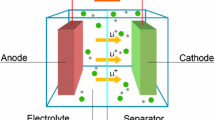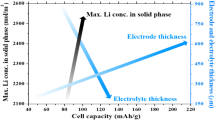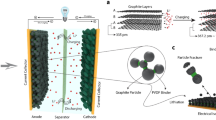Abstract
Mathematical models can predict the performances of batteries, such as their state of charge and state of health. Among physicochemical governing equations, Fick’s first and second laws describe ionic intercalation and solid-state diffusion in electrode particles, respectively. Conventionally, molar concentration and current density are the main descriptors for ionic intercalation and solid-state diffusion in the electrochemical models. However, more relevant and typical descriptors for rechargeable batteries are intercalation quantity (i.e., x in LixC6) and C-rate. Herein, we translate the governing equations of Fick’s laws based on intercalation quantity and C-rate, instead of the molar concentration and current density. The new governing equations enabled faster computation of the electrochemical models, benefited by the intrinsically dimensionless properties of the descriptors. Moreover, the newly derived equations provide a practical insight to design the morphology of particles for the improved rate capability. Implementing the newly derived governing equations to a single-particle model demonstrated faster, efficient, and reliable simulation to investigate the effects of particle size, diffusivity, and C-rate on lithium-ion batteries performances. These new governing equations can be implemented in various models for batteries in general, enabling an efficient computation and facilitated communication among researchers investigating energy storage.
Graphic abstract









Similar content being viewed by others
Abbreviations
- t :
-
Time [s]
- D :
-
Solid-state chemical diffusion coefficient (or, diffusivity) [cm2 s−1]
- n :
-
Orthonormal vector on the electrode–electrolyte boundary for ion intercalation (positive direction: from electrode to electrolyte)
- C-rate:
-
Ratio of charging/discharging current to current that charges/discharges the intercalation host in one hour [h−1]
- C-rate :
-
Dimensionless C-rate, which is equivalent to C-rate [h−1] × 1 [h]
- V :
-
Volume of an intercalation host [cm3]
- S :
-
Microscopic surface area into which ions can intercalate [cm2]
- c :
-
Local concentration of ions in the host [mol cm−3]
- z :
-
Ion charge number
- F :
-
Faraday’s constant, 96,485 [C mol−1]
- R :
-
Universal gas constant, 8.3145 [J mol−1 K−1]
- T :
-
Temperature [K]
- ρ :
-
Density of intercalation host [g cm−3]
- Q :
-
Theoretical specific capacity of intercalation host [C g−1]
- x :
-
Intercalation quantity, x = czF/ρQ
- v :
-
Intercalation velocity [cm s−1] = \(- D\nabla x\), which can be regarded as the propagation vector of the intercalation quantity
- i :
-
Current density [A cm−2]
- i 0 :
-
Exchange current density [A cm−2]
- η ct :
-
Charge transfer overpotential [V]
- α :
-
Charge transfer coefficient
- U(x):
-
Open-circuit potential [V] as a function of x
- V(x):
-
Cell voltage [V]
- ESR:
-
Equivalent series resistance [Ω cm2]
References
Scrosati B, Garche J (2010) Lithium batteries: status, prospects and future. J Power Sources 195:2419–2430. https://doi.org/10.1016/j.jpowsour.2009.11.048
Minakshi M, Singh P, Sharma N, Blackford M, Ionescu M (2011) Lithium extraction−insertion from/into LiCoPO4 in aqueous batteries. Ind Eng Chem Res 50:1899–1905. https://doi.org/10.1021/ie102267x
Minakshi M, Visbal H, Mitchell DRG, Fichtner M (2018) Bio-waste chicken eggshells to store energy. Dalton Trans 47:16828–16834. https://doi.org/10.1039/C8DT03252A
Minakshi M, Higley S, Baur C, Mitchell DRG, Jones RT, Fichtner M (2019) Calcined chicken eggshell electrode for battery and supercapacitor applications. RSC Adv 9:26981–26995. https://doi.org/10.1039/C9RA04289J
Minakshi M, Mitchell DR, Jones RT, Pramanik NC, Jean-Fulcrand A, Garnweitner G (2020) A hybrid electrochemical energy storage device using sustainable electrode materials. ChemistrySelect 5:1597–1606. https://doi.org/10.1002/slct.201904553
Dees DW, Battaglia VS, Bélanger A (2002) Electrochemical modeling of lithium polymer batteries. J Power Sources 110:310–320. https://doi.org/10.1016/S0378-7753(02)00193-3
Santhanagopalan S, Guo Q, Ramadass P, White RE (2006) Review of models for predicting the cycling performance of lithium ion batteries. J Power Sources 156:620–628. https://doi.org/10.1016/j.jpowsour.2005.05.070
Manzetti S, Mariasiu F (2015) Electric vehicle battery technologies: from present state to future systems. Renew Sust Energ Rev 51:1004–1012. https://doi.org/10.1016/j.rser.2015.07.010
Shepherd CM (1965) Design of primary and secondary cells II. An equation describing battery discharge. J Electrochem Soc 112:657–664. https://doi.org/10.1149/1.2423659
Buller S, Thele M, Karden E, De Doncker RW (2003) Impedance-based non-linear dynamic battery modeling for automotive applications. J Power Sources 113:422–430. https://doi.org/10.1016/S0378-7753(02)00558-X
Zhang S, Xu K, Jow T (2006) EIS study on the formation of solid electrolyte interface in Li-ion battery. Electrochim Acta 51:1636–1640. https://doi.org/10.1016/j.electacta.2005.02.137
Kim J-H, Lee S-J, Kim E-S, Kim S-K, Kim C-H, Prikler L (2014) Modeling of battery for EV using EMTP/ATPDraw. J Electr Eng Technol 9:98–105. https://doi.org/10.5370/JEET.2014.9.1.098
An Y, Jiang H (2013) A finite element simulation on transient large deformation and mass diffusion in electrodes for lithium ion batteries. Modell Simul Mater Sci Eng 21:074007. https://doi.org/10.1088/0965-0393/21/7/074007
Meng J, Luo G, Ricco M, Swierczynski M, Stroe D-I, Teodorescu R (2018) Overview of lithium-ion battery modeling methods for state-of-charge estimation in electrical vehicles. Appl Sci 8:659. https://doi.org/10.3390/app8050659
Doyle M, Fuller TF, Newman J (1993) Modeling of galvanostatic charge and discharge of the lithium/polymer/insertion cell. J Electrochem Soc 140:1526–1533. https://doi.org/10.1149/1.2221597
Fuller TF, Doyle M, Newman J (1994) Relaxation phenomena in lithium-ion-insertion cells. J Electrochem Soc 141:982–990. https://doi.org/10.1149/1.2054868
Fuller TF, Doyle M, Newman J (1994) Simulation and optimization of the dual lithium ion insertion cell. J Electrochem Soc 141:1–10. https://doi.org/10.1149/1.2054684
Doyle M, Newman J (1995) The use of mathematical modeling in the design of lithium/polymer battery systems. Electrochim Acta 40:2191–2196. https://doi.org/10.1016/0013-4686(95)00162-8
Zhang T, Guo Z (2014) Effects of electrode properties and fabricated pressure on Li ion diffusion and diffusion-induced stresses in cylindrical Li-ion batteries. Modell Simul Mater Sci Eng 22:025016. https://doi.org/10.1088/0965-0393/22/2/025016
Santhanagopalan S, White RE (2007) Online estimation of the state of charge of a lithium ion cell. ECS Trans 3:191–208. https://doi.org/10.1016/j.jpowsour.2006.04.146
Di Domenico D, Stefanopoulou A, Fiengo G (2010) Lithium-ion battery state of charge and critical surface charge estimation using an electrochemical model-based extended Kalman filter. J Dyn Syst Meas Contr 132:061302. https://doi.org/10.1115/1.4002475
Chaturvedi NA, Klein R, Christensen J, Ahmed J, Kojic A (2010) Algorithms for advanced battery-management systems. IEEE Control Syst Mag 30:49–68. https://doi.org/10.1109/MCS.2010.936293
Li J, Wang D, Pecht M (2019) An electrochemical model for high C-rate conditions in lithium-ion batteries. J Power Sources 436:226885. https://doi.org/10.1016/j.jpowsour.2019.226885
Guo M, Sikha G, White RE (2011) Single-particle model for a lithium-ion cell: thermal behavior. J Electrochem Soc 158:A122–A132. https://doi.org/10.1149/1.3521314
Bower AF, Guduru PR (2012) A simple finite element model of diffusion, finite deformation, plasticity and fracture in lithium ion insertion electrode materials. Modell Simul Mater Sci Eng 20:045004. https://doi.org/10.1088/0965-0393/20/4/045004
Moura SJ, Argomedo FB, Klein R, Mirtabatabaei A, Krstic M (2017) Battery state estimation for a single particle model with electrolyte dynamics. IEEE T Contr Syst T 25:453–468. https://doi.org/10.1109/TCST.2016.2571663
Li J, Adewuyi K, Lotfi N, Landers RG, Park J (2018) A single particle model with chemical/mechanical degradation physics for lithium ion battery state of health (SoH) estimation. Appl Energy 212:1178–1190. https://doi.org/10.1016/j.apenergy.2018.01.011
Santoki J, Schneider D, Selzer M, Wang F, Kamlah M, Nestler B (2018) Phase-field study of surface irregularities of a cathode particle during intercalation. Modell Simul Mater Sci Eng 26:065013. https://doi.org/10.1088/1361-651X/aad20a
Zhang D, Popov BN, White RE (2000) Modeling lithium intercalation of a single spinel particle under potentiodynamic control. J Electrochem Soc 147:831. https://doi.org/10.1149/1.1393279
Du W, Xue N, Sastry AM, Martins JR, Shyy W (2013) Energy density comparison of Li-ion cathode materials using dimensional analysis. J Electrochem Soc 160:A1187–A1193. https://doi.org/10.1149/2.069308jes
Wagner S, Oberland A, Turek T (2016) Analytical approach for evaluation of lithium-ion battery cells. Energy Technol 4:1543–1549. https://doi.org/10.1002/ente.201600137
Stephenson DE, Hartman EM, Harb JN, Wheeler DR (2007) Modeling of particle-particle interactions in porous cathodes for lithium-ion batteries. J Electrochem Soc 154:A1146–A1155. https://doi.org/10.1149/1.2783772
Weisstein EW "Oblate Spheroid." From MathWorld--A Wolfram Web Resource. https://mathworld.wolfram.com/OblateSpheroid.html.
Lain MJ, Brandon J, Kendrick E (2019) Design strategies for high power vs. high energy lithium ion cells. Batteries 5:64. https://doi.org/https://doi.org/10.3390/batteries5040064
Li J, Shunmugasundaram R, Doig R, Dahn JR (2016) In situ X-ray diffraction study of layered Li–Ni–Mn–Co oxides: effect of particle size and structural stability of core–shell materials. Chem Mater 28:162–171. https://doi.org/10.1021/acs.chemmater.5b03500
Acknowledgements
This work was supported by the National Research Foundation (NRF-2018R1C1B6004808 and NRF-2018R1A5A1025594) of the Korean Ministry of Science and ICT. The authors are grateful to Mr. Fuead Hasan for the careful proofreading of the manuscript.
Author information
Authors and Affiliations
Corresponding author
Additional information
Publisher's Note
Springer Nature remains neutral with regard to jurisdictional claims in published maps and institutional affiliations.
Rights and permissions
About this article
Cite this article
Kim, J., Mohanty, S.K. & Yoo, H.D. Modeling ionic intercalation and solid-state diffusion using typical descriptors of batteries. J Appl Electrochem 51, 703–713 (2021). https://doi.org/10.1007/s10800-021-01530-8
Received:
Accepted:
Published:
Issue Date:
DOI: https://doi.org/10.1007/s10800-021-01530-8




